Reclaiming the Breast
Origins
So, I have come to the end of my masters degree in Graphic Design. I have also been pregnant and had a baby since I updated this blog. This is relevant, as it shaped the last, major project of my course.
This project began life rather organically. All the work undertaken during the course of this Masters degree has had several things in common. The themes throughout have been based in the domestic environment, encouraging the audience to feel comfortable either in surroundings familiar to them, or reclaiming space that is not theirs. And…most crucially, most of my work has involved craft and making.
My work has always had a light hearted and fun element, with a focus on inclusivity.
The actual ‘cause’ that this project eventually championed was not something that was initially on my radar when I the course began.
Circumstances dictated that change of focus. My fine art background ensured that the end result was arrived at albeit by circuitous means.
My favourite ‘piece’ from previous projects was a pair of silicone breasts. These were made simply because they would look and feel nice to hold. As an extension of the module, which involved manufacturing giant eyes for people to have in their homes, to encourage feelings of safety, the boobs were also there to engender comfort and security (but I was also aware they would be sexual and fun in a Benny Hill kind of way).
I liked how the silicone and wooden breasts I made, took on a much more benign and tactile existence when removed from the more realistic and photographic image of breasts. They became something which could be seen in public, rather than being pornographic and hidden from young eyes.
Children love breasts: they brought them sustenance and comfort as babies.
Another major factor was the fact that I enjoyed making the breasts, both in process and design. Choosing the shapes and colours was very satisfying.
Deciding the context in which to carry this forward was another natural decision. In July 2012, I found out I was pregnant and began to see my own breasts in an entirely different context.
My boobs became a tool of the trade and a way of making my child thrive; the most natural thing in the world without which the human race would not exist.
Looking at Breast Cancer
Before becoming pregnant, I had been sniffing around for a context/ cause in which I could shoehorn my made bazookas. Initially I was looking into Breast cancer. I instantly felt uncomfortable with this option. I am a student. I know nothing about breast cancer. I am not a tactful person. I am not worthy.
Although breast cancer marketing has had a firm focus on fun and friendly campaigns, it is not something I could confidently promote without the fear of upsetting or offending cancer patients. (even finding the right words here is hard- can you call them cancer sufferers?)
It seems to me that treating cancer in this country and actually in the world is pretty much covered in an irreverent way. Why try and add to an area already saturated with successful awareness campaigns.
Whilst looking at the breast cancer angle, I did look at some fantastic marketing campaigns in the UK and abroad. The ‘Race for Life’ events for ‘Cancer Research UK’ have become massive earners for the charity. The branding for this has made it unmistakable. The use of the pink ribbon to denote breast cancer support has become ubiquitous.
Taking it a little more adult and risqué are the ‘Facebook’ campaigns to encourage women to write suggestive status updates about where they put their handbag when they get home “I like it on the floor”, creating a secret language for those in the club.
New Zealand had an imaginative awareness campaign featuring a giant tumour following women down the street, or filling up their houses- actually addressing the denial of the prospect of the cancer itself.
All of these things have something in common- they don’t actually show you the breasts. Is there something so offensive with the actual articles? Have breast become too sexualised that the human form needs to be censored?
A Japanese company has developed a self adhesive breast examination tool which shows women how to check their breasts for lumps. It is essential that this clearly shows how it is to be used.
I played around with using a light-hearted approach to the subject, rather than simply ‘raising awareness’. Awareness campaigns seemed a bit pointless really. A more useful strategy would be to promote how to purposefully check yourself, especially aimed at the younger generation.
I looked at using more risqué and less formal language, could breast pasties be used? Now- these photos are not the way this is intended to be viewed, just documentation of the articles produced. I was nervous about the obvious sexual nature of these. I was trying the make breasts seem natural and not objects of desire in the male gaze. I think this line of work failed.
Could a campaign involving stickers in ladies loos be successful in encouraging women to cop a feel?
Stickers of images of hands could be placed at the average breast height, so when a woman stands in the mirror, the ‘hands’ appear to be hovering or touching her breasts. I actually really like this idea, and may play around with it at a later date…
Breast Feeding Research
Anyway, breast cancer is more than covered by the world of awareness campaigns and design. I got pregnant and everything changed…
As it dawned on me that my body was no longer my own to do with as I wished, attention turned to my relationship with my breasts and the job they were about to embark upon.
After speaking to friends and family I realised that breastfeeding has been a dwindling activity in the western world over the past thirty odd years.
The current child bearing generation appears to not see breastfeeding as an essential requirement of motherhood. The proliferation of formula feeding and the saturation of marketing (although illegal to advertise breast milk substitutes) have encouraged mothers to enjoy the benefits of formula feeding, rather than the benefits of breast feeding for their child. Whereas an infant two hundred years ago may have died without breast milk, nowadays a mother can quite easily feed using formula and a bottle.
This issue is strangely under represented on the national set of ‘awareness’ campaigns. Sheffield council has provided a year on year decrease in funding for National Breastfeeding Awareness Week with 2013 receiving no funding whatsoever.
The reasons why women choose not to breastfeed are many and complex. Many women have decided not to breastfeed before the birth of their babies, and a great deal stop after the first week or two due to problems faced.
There is a huge amount of mother’s guilt associated with breast feeding and feeling of inadequacy plus fears of failure to continue. Anecdotally, many mothers I have spoken to, regret giving up. The major reason cited was being unable to find the support to continue through problems.
As a middle class thirty something, statistically I was much more likely to initiate breastfeeding, and also feel comfortable finding and asking for advice. The social demographic most unlikely to initiate breastfeeding is the white working class women aged between 16 and 24. Is this the group that I should choose to focus on?
After interviewing specialist midwives and public health workers it became apparent that many women of this social group saw their breasts as sexual objects and did not feel that they owned their breasts. Rather, they needed to be preserved for the male gaze. Many of these women were not breastfed themselves and their peers predominately bottle-feed.
One of the midwives interviewed stated that teenagers could be persuaded to change their views on things whilst their minds are malleable to new suggestions. Is it possible to change their minds and make breast feeding seem natural and normal? Is it the whole family who needs educating rather than just the mother?
Anecdotally, many women not planning to breastfeed are able to change their minds on the subject during this first encounter.
From personal experience as a pregnant woman, every single antenatal appointment involves the subject of breastfeeding. All pregnant women are made aware of the benefits to the child of breastfeeding.
The most high profile campaign in the last 10 years has been the Hub’s ‘Be a Star’ campaign. This took young mothers and gave them makeovers and had photo shoots with them breastfeeding. This appealed to the girls craving celebrity culture. Although striking and at first look, successful, initiation rates dropped when the campaign finished.
Other countries use slightly more graphic imagery to address this problem. There is still a fear of showing the breasts in marketing campaigns that involve breastfeeding. I also visually researched one hundred breastfeeding logos to see common themes, colours and representations of the female form.

‘Designer Mum, Designer Milk’ poster by Sophie Barker and Kayleigh Brooks for Best Beginnings, a project run with Central Saint Martins design students. 2008
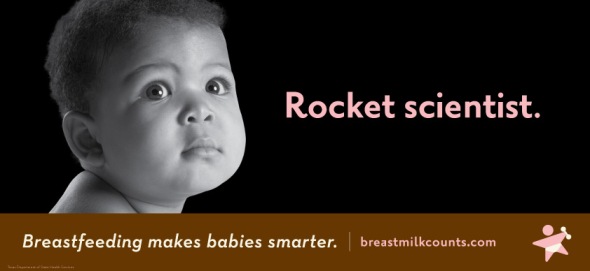
‘Rocket scientist’ Ad from Breastmilk Counts campaign by Texas Department of State Health Services 2011
I have decided to use Sheffield as an area of study on both breastfeeding initiation rates and methods used to encourage breastfeeding. UNICEF, the world authority on breastfeeding, has granted Sheffield ‘Baby Friendly’ status. This has been achieved by providing training to all health care professionals involved in maternity care. Sheffield has a massive range of support for breastfeeding mothers…if you know where to look.
Sheffield is a leader when it comes to breastfeeding support in the UK, and can be used as an exemplar of successful rates of continuation of breastfeeding in the north of England. Sheffield has a 78% initiation rate for breastfeeding mothers. Although this drops dramatically after six weeks, this is a national problem rather than a local one.
When in the Jessop’s Wing of the Royal Hallamshire Hospital, after the birth of my son Billy Bob, I was approached by every midwife on duty, anciliairy staff and visiting peer support workers offering help with breastfeeding. In the delivery suite, all women are encouraged to breastfeed, even if it is only whilst in hospital so the child benefits from colostrum, the first incredibly nutritious milk.
With all of this knowledge of breast feeding initiation along with knowing the reasons why women choose not to breastfeed at all, what is it that I think I can achieve with my work, and who exactly am I appealing to?
Obviously as a graphic designer you work on briefs outside your own awareness/ comfort zone. Your job is to communicate and include audiences with whom you do not share a common language.
The audience for my work are those who do not initiate breastfeeding to begin with. Perhaps they are the ones most in need. If we could change their minds, even momentarily, we could make sure more babies have colostrum if nothing else.
I am aware of the health benefits of breastfeeding both to my baby and myself. I come from a stable domestic set up, I was breastfed and I want to breastfeed. But I still need help.
I have identified three areas to focus on:
- Normalising breastfeeding
- Helping mothers find support
- Helping mothers find safe and comfortable places to breastfeed.
Normalising Breast Feeding
All women know that breast is best. Does this need to be hammered home even more? It can be quite a pressured environment to talk about if choosing to take up breastfeeding.
Is it the case that there should be a shift in the view of breasts at a much earlier age? So, rather than targeting pregnant young women, I am targeting young people, including men, before conception as well as after.
This is a big ask. Even the ‘No More Page Three campaign’ started by a petition on change.org by Lucy Holmes is suffering from publishers and readers seeing the sexualisation of breasts as harmless and ‘a bit of fun’. ‘Page three’ appears the only place where tits can be seen in public without causing offence to the general public. David Cameron has repeatedly swayed on the side of Rupert Murdock and Dominic Mohan (Sun editor) whilst apparently committing to raising the rates of breastfeeding initiation and continuation. David Dinsmore, the new editor of the Sun, claims he plans to keep the page three models as they ‘promote natural beauty’. Although it is widely believed this is due to a fear of the falling reader numbers tumbling even more. If a ‘family newspaper’ promotes viewing women as objects, and breasts as something for titillation, it’s no wonder young women do not feel confident using their breasts as they were designed for.
Women need to reclaim their breasts. They need to see them as tools of the trade and something to be proud of. Can using the imagery of breasts be done without sexualizing them?
Aside from the photographic/ video form, it is fairly simple to make breasts anodyne using arts and crafts (apart from the highly sexual Chun-Li character’s shower scene in the street fighter animated film). They become cuddly, tactile and family friendly even.
The language of breasts and breastfeeding is generally very sensitively approached. I chose to ignore this rule by using popular culture terms including tabloid speak and song lyrics. I painted placards to be used at travelling events and photographed text to be used in print. Children’s toys were used in the imagery to put it in context.
I conducted a very quick Facebook survey to find some commonly used words and phrases to describe breasts.
I played around with creating my own typography for language used in printed materials using hand drawn letters. Although I really enjoyed doing this the use of words actually was not needed so much as I increasingly relied on objects and patterns in my designs.

‘Express yourself’ on the fridge

‘tits for tots’ possible placard or poster campaigns using popular culture as references. How about ‘Nips for Nippers’? Acrylic on plywood 50x70cm
Pop Up Restaurant
Another set of work embarked upon which I would like to pursue further is the ‘pop up’ restaurant sign placed in various outdoor and unusual places. I designed and made a Las Vegas style sign complete with LED lights. This was suitable to be transported and displayed wherever women choose to breastfeed. For example park benches, train carriages and beaches. This follows the current trend of pop up restaurants and shops in London. Photographs of the sign in these locations could be used as a print campaign. Removable stickers could also be produced to be applied where women have found themselves feeding.
Support
For those Mother’s who have chosen to breastfeed, making information available on support is invaluable. Sheffield, particularly has a great deal of support available if you know where to look. Making this information easier to get both from road shows and poster campaigns could be very useful.
As making is my passion, it was a case of deciding which craft to use as appropriate.
Most midwives and health professionals dealing with breastfeeding use knitted breasts to illustrate positioning and attachment of babies –could this craft language be extended?
With the help of my mother, I knitted thirty breasts to be used as teaching aids like the ones knitting nannas make. They also make a fun display for feeding rooms/ breastfeeding pop-up displays.
Using CNC routed plywood I created a moveable wall with castors for the breasts to be displayed, with space for information to be stuck on the back using specially made magnets.
The knitted boobs were made using vaguely skin coloured yarns, to attempt to represent the human form. The majority were made to illustrate Caucasian skin but a few more were of various shades to represent black and Asian tones. The shades were probably representative of the population but also it must be pointed out that, culturally, white English women are least likely to breastfeed. Black and Asian women have feeding much more culturally entrenched, with support from family members making this normal and easier to achieve.
I have seen many of the grannies’ knitted boobs that health visitors etc carry around with them in bright blues and greens due to using up any spare wool they had. I did consider using this technique but preferred skin tones as it kept them life like enough to be viewed as body parts.
The pattern for the knitted boobs can be passed around, either for ladies to add to the wall of boobs, to create their own wall of boobs at children’s centres, or to donate for training purposes to hospitals.
These need to be housed in some kind of moveable structure, to both entice people close, and to create a space for quietly feeding and receiving information and support.
Nawal El-Amrani, the infant feeding co-ordinator for Sheffield council, cares passionately about getting women the right kind of information to encourage the upkeep of breastfeeding. She is responsible for disseminating all information to health visitors, midwives and peer support workers about correct breastfeeding techniques.
Incidentally, the language used was very important, I was told by Nawal that my use of the word ‘advice’ was not appropriate, as this can suggest the midwives’ ability to solve the mother’s feeding problems rather than guiding them to solutions.
What better way to grab people’s attention than by a giant breast? Initially I thought making a fabric boob stretched over a framework could do this.
This idea progressed into the concept of being able to get inside the breast, hence the ‘titty tepee’. Although the model looked pretty cool, the shape and colours were not realistic and striking enough for it to be recognised as a breast from far away.
I developed a design for a collapsible tent, more like a dome tent that could be made and transported to various venues, including parks and festivals. This was definitely more identifiable as a breast, and would be big enough to fit at least five or six people comfortably. The size meant that this could be used to house a support worker along with some comfortable chairs for feeding in good weather, but also for the information displays and such, during bad weather.
After working out costs and metres of fabric needed, it became clear that the prohibiting factor was not the cost, but the size of the structure. When dismantled it would be huge, as this, like the wall of boobs, would be CNC routed plywood.
The shape needs to remain the same, but the framework would be much better made from fibreglass tent poles like a traditional dome tent.
As mentioned, I would like to use this tent to travel to parks, festivals and shopping centres, where there may be mothers with problems with feeding. They may like help, or desire privacy. This also could be taken to sites to pre-empt potential parent’s worries regarding breastfeeding- for instance having a pop-up information point in places where there is a high incidence of teenage pregnancy.
I had grand ideas about other possible permanent structures being used for spreading imagery of breasts as non-sexual objects.
I would love to see the cement dome in Heeley with a painted nipple; seen from Google Earth it would look rather fun and incongruent.
Instead of having a permanent coat of paint on, it could be wrapped a la Christo. This could be extended to any dome like structure, although I may have trouble persuading the Imam that the Wolsey Road Mosque would look good with it.
Serious research needs to be done into how something as overt as a nipple shaped tent would be treated by the target audiences. Would it be something that would be an alluring sight, bringing people towards it out of curiosity, or would it be a repellent to the more shy or self-conscious?
Although I have had positive feedback on the design from Nawal El-Amrani, I am unsure how the younger women would feel about it.
All this knitting inspired me to make a more accurate model of breasts. These breasts carried by health professionals are essentially teaching aids, so it seemed appropriate to make an anatomical model of the breast.
An understanding of how the breast is constructed could help to reduce the chances of developing or alleviating mastitis. For this to be successful, it needed to be anatomically accurate. Amazingly, it was only recently that the make up and function of the breast was studied in depth. The constituents of breasts were wrongly illustrated, as they had not been studied properly. Unicef now uses an illustration wildly different from that taught in medical circles even five years ago. (See appendix 8) As a consequence, I have had to adjust my knitted model, as I based it on images found on the Internet that were not up to date with current thinking.
This model, due to its size, it designed to be used in a permanent clinical setting, explaining to mothers how the milk is formed and stored, as well as to show how, where and why problems including mastitis may occur.
Talking to Nawal from the council was useful in many ways. It introduced me to a new level of bureaucracy that she encounters frequently with the council, and also the strict guidelines about information dissemination imposed through the Unicef Baby Friendly Initiative.
Nawal is incredibly knowledgeable and passionate about what she does, but is restricted massively by budgetary and bureaucratic restraints.
So as to ensure a coherent and continuous level of care, all feeding information must be the same. Unicef officially does not encourage the use of nipple shields, breast pumps or other methods, which anecdotally have helped mothers through difficulties with feeding.
Although these methods work for many women, they are not encouraged and therefore should not be mentioned in printed or web materials for women. This is very much the same with formula milk. Gaining information about correct formula feeding is incredibly hard work, if going through the official channels.
Safe Places
Would making the environments where women feed outside the home more pleasant help in some way to make new mothers feel comfortable with breastfeeding? Although ideally all women should be confident and encouraged to breastfeed in public, sourcing rooms and places available to breastfeed out and about in privacy may go some way to introducing them to breastfeed away from the home.
Anecdotally, although Asian women are more likely to breastfeed, they are more uncomfortable about doing this in public. This is why the private feeding rooms in public buildings are also very important. The privacy creates a freedom to leave the house where many women would feel trapped at home.
For example, Meadowhall has three such rooms. There is a quiet and comfortable room located off a corridor in the food quarter dedicated to feeding, with two sofas and a lock on the door. There are also two feeding rooms in the Mothercare store. One of these doubles as a changing room, with bottle heaters and hand washing facilities. The other has two reclining armchairs and a water fountain. Although both of these rooms are fairly comfortable and private, they look pretty ugly and uninspiring. If these rooms were ‘jazzed up’ a bit, they could act as examples of great breastfeeding spaces, for mothers too scared to come shopping when feeding and also to other organisations catering for a young female clientele.
IKEA is a great example of family friendly facilities. Rather than having a dedicated breastfeeding room the restaurant has a cordoned off section for feeding infants creating a private and fun environment for Mothers and children alike.
Kiddicare, as the name would suggest is a new company specializing in baby and children’s products. It appears to be leading the pack with regards to in-store facilities for nursing mothers.
In a bid to appeal to the more nervous mother/ expectant mother, I have looked at using repeat patterns to soften the impact of giant breasts.
Pattern and branding became important to the design to make the work recognisable when used in multiple places across the city.
I created soft furnishings and wallpaper designed to be suitable for ‘on the road’ displays and potentially for the decoration of feeding rooms in public buildings.
For the modesty screen and the cushions I used the screen-printing technique. A three-colour separation and single colour outline were used of the repeat pattern design. The outline design appears more successful as it abstracts the image of the breast.
Thankfully Mike MacGabbhan in the printmaking dept of SHU was able to help me with the screen-printing process, as I was too heavily pregnant to reach the bed properly!
All the fabric was sewn together my myself and my Mother.
Ideally, these kinds of rooms could be wheeled out across the city, perfect for breastfeeding mothers who have returned to work and either have their baby come in to feed during the day, or who have to express milk in their breaks. Both of which are fairly common practices. By law, breastfeeding mothers need to be given the time and space to continue breastfeeding in the work environment, but most workplaces do not have dedicated space for this. Many women working in schools, colleges and hospitals –large organisations, within the public sector- find themselves in cupboards, toilets and corners expressing in their lunch hour, unable to eat or read in the dark in such places.
As so much of my work is designed to be transported, it seemed right to print some branded boxes to carry the models.
One road I travelled, only to find myself in a cul de sac, was the attempted rebranding of the Sheffield Breastfeeding Friendly Awards. This is a council led initiative, designed to collate a list of premises open to breastfeeding women. These are primarily public sector buildings, including council buildings and libraries and children’s centres. Also included are a large amount of cafes and restaurants.
In an attempt to lure more businesses into joining the scheme, I began designing actual awards for the cafes etc to display. Currently the buildings are given window stickers to entice feeding mothers inside, but I wanted to give them even more of an incentive to join up.
I thought about barbers’ poles, with the stripe snaking down it being blue, like the milk straws of our youth. However, I came up with a more overt, silicone and acrylic breast, with a straw coming out of it, as an object; and a print and web based illustration of this for stickers and 2D signs.
One point worth mentioning here is that Nawal did not think the straw coming out of the nipple was appropriate, as it suggests the baby drinks from the nipple which, although the milk comes out from the nipple, the baby latches on and sucks from much further onto the breast. All subsequent designs will have the straw removed.
This area of work failed for two reasons. Firstly, the imagery was a shade too blatant, too obvious and lacking a bit too much in humour. Secondly, producing the models would be much too costly; the council would not have the funding to produce anything other than the window stickers.
My Work in Use
In order to evaluate the response to my work, in mid May 2013, I displayed it within the University. The work was assembled to create a breastfeeding room ‘set up’ complete with play mat and furniture for toddlers to play on.
I invited all the people I had spoken to about my work and encouraged new mothers to come along via Facebook. The feedback was really interesting. Although I had feedback forms and an online survey, it was face to face conversations from which I gained the most information.
Many women had no idea how much help was available but those who had problems found the support invaluable in their continuation of breastfeeding. No one was shocked by the amount of crafted breasts on show; in fact they were greeted with surprise humour and smiles.
“For me it was a very playful way to catch attention that is essential for a campaign to succeed. We live in a sexualised society, but these breasts did not evoke any sexual image.” –feedback from visitor
I was particularly pleased to have several mothers happy enough to feed their children in the space itself whilst their older siblings were entertained with the wall of boobs.
One respondent to the online survey suggested there could be more toys, I would like to take this further in the future, and design some more breast inspired toys plus a black and white pattern book for babies.
Many people commented favourably on the pattern, both in the large-scale format of the wallpaper, and the screen, without realising it was representing breasts.
My work was used (for free) by Nawal (El-Amrani, the Infant Feeding co-ordinator for the council) for the annual National Breastfeeding Awareness Week’s picnic in the Winter Gardens this year.
Initially she had wanted to commission me to make the breast shaped dome tent, but had her budget cut to zero.
Nawal suggested seeking funding to make the tent, and she may have been able to find enough money to rent it from me, but this proved impossible too. She has pointed out to me that other councils and organizations may be interested in renting it for similar events in other cities so I may well do this in the future.
As part of the National Breastfeeding Week my work was displayed in the Winter Gardens in Sheffield City centre. A breast feeding picnic had been organized and my work acted as a backdrop. Babies and toddlers enjoyed playing with the knitted breasts. There were many breastfeeding workers in attendance talking to passers-by and new Mothers. The picnic gained a great deal of attention from members of the public who were passing by, due to the wall of boobs as well as the many women who were breastfeeding.
The picnic featured in the Sheffield Star’ newspaper but interestingly it omitted to include any photographs of women breastfeeding. As the event was national it attracted many articles in the national press. A great many of these were very disparaging about militant breastfeeding advocates. This reiterated the point that all breastfeeding support needs to be non- judgmental and inclusive.
Again the feed back garnered from talking to new Mothers was positive with regard to making more breastfeeding room/areas feel fit for purpose.
There was a Breastfeeding World Record Attempt in Barnsley (part of the Big Latch On) this summer to try and get the most amount of women breastfeeding in one place. As this happened in a park, this would have been the ideal place to take the tent. I took along the ‘Pop-Up Restaurant’ sign and had this above where I was feeding.
I also took the sign to Sheffield’s Tramline’s music festival, and asked a friend to hold the sign above me as I fed Billy Bob. I think this might have looked slightly strange!

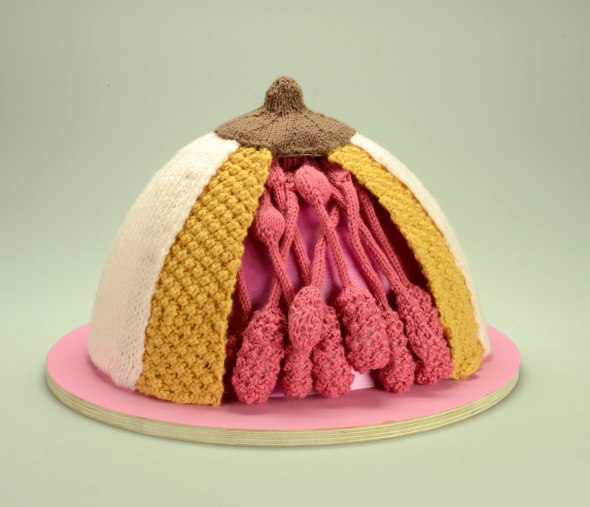










































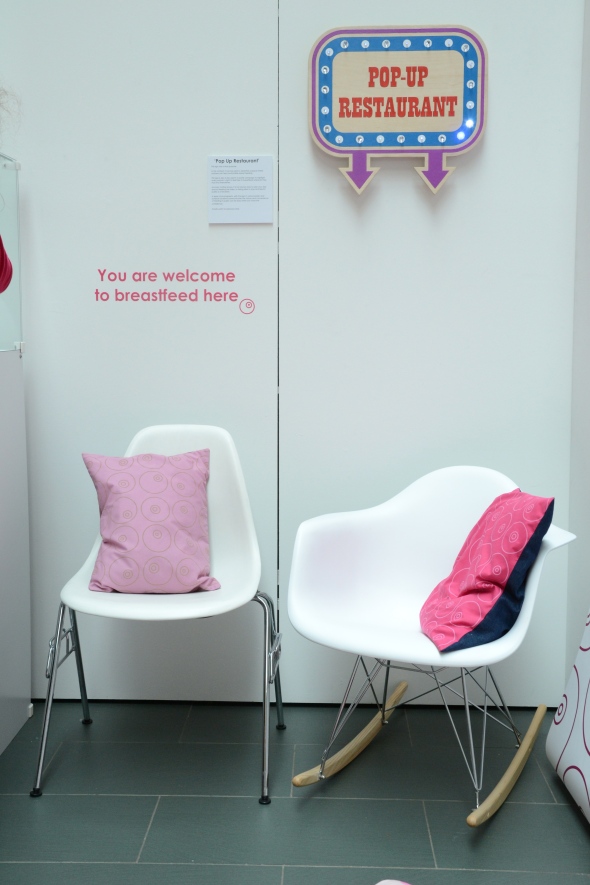

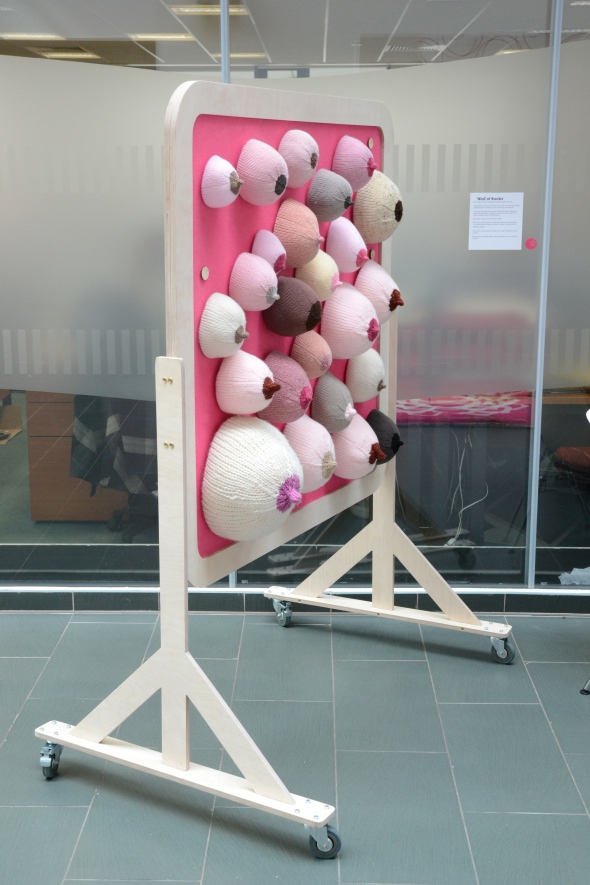
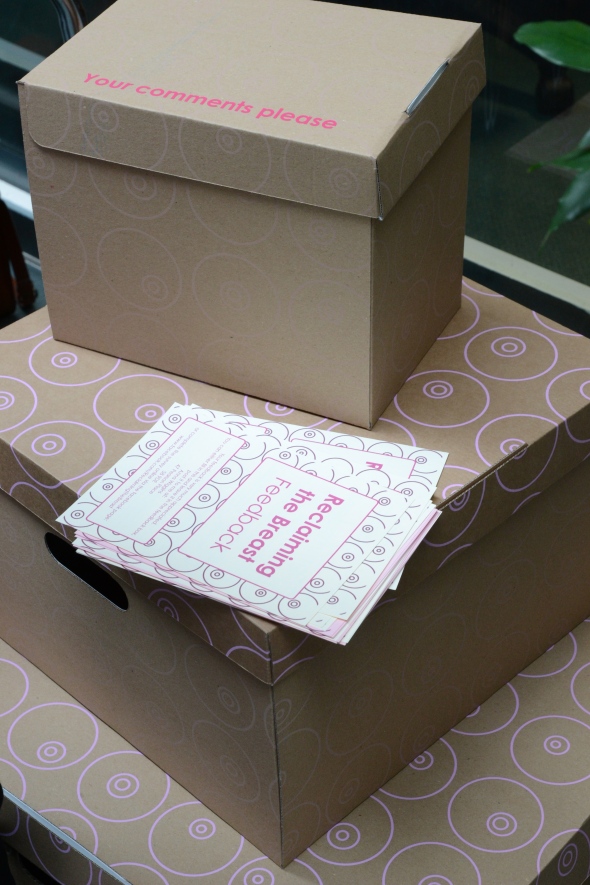
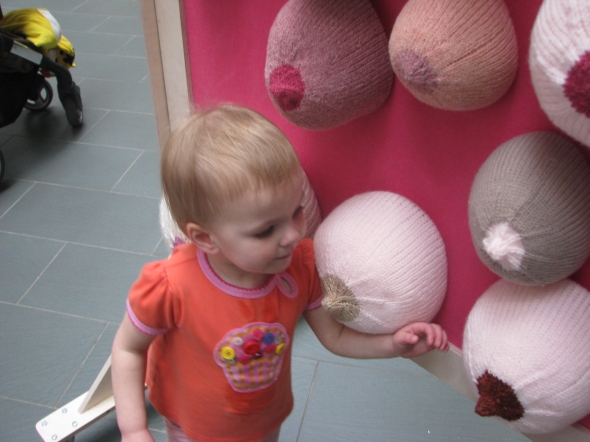



[…] Reclaiming the Breast […]